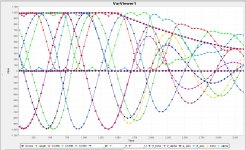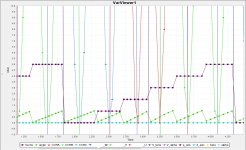Mihai_F
100 W
- Joined
- Oct 11, 2021
- Messages
- 128
hello to all,
I have studied FOC motor control for a good while now, i understanded most of it. If i remember well you have done you own FOC code, so i have some questions about FOC algorithms to clear things out.
So far i understand and made (code) the following: clark transform from Ia, Ib, Ic to alpha and beta, then park transform to d and q, here are 2 formulas one for d aligned with alpha and one for q aligned with alpha, i used q aligned with alpha in order to have a positive q (the other one gives a negative q), then a simple command for d and q no PID yet, then inverse park to get alpha and beta from commanded d and q, then find the theta angle and modulation index from alpha and beta, then from here i used some code i found on github for SVPWM dutycycles, wich i kinda get what it does but not completely.
So basically i run this code in STM32F401(black pill) to simulate FOC and i produce artificially 3 sines 120 deg apart, at ~1Hz, and watch all computed FOC variables on var viewer of stm studio, i can change the q and that changes the SVPWM, plus i give feedback to my artificial sines to be more real situation/simulation.
The question are:
1. The theta angle (rotor angle) calculated from atan2(beta, alpha), can be used in sensorless/encoderless FOC algoritm, will it work?, is that the right way of doing FOC?
2. Why is SVPWM out of phase 180deg from initial input sines U V W, in the screenshot?, i do not think that is right...
3. I will use hall sensors only for startup, should i use them to find the theta angle and sector from them after startup on the runn?
4. I plan to use STM32F407ZG (168Mhz) and 3 hall current sensors on phases, and have Tim1 channel 1,2,3 center aligned complemetary pwm generation (mode1) and channel 4 output compare to trigger ADC in the center of the PWM pulse, ADC1 injected ch1, ch2 and ch3 sequential order , is this the "correct/good" way to do things?
5. If i understand well, if ARR is 1000 and q comand is 0 then all 3 duty clycles are at 500, all fets swithcing all outputs fom high to low (comlementary PWM half on, half off of the time), in that case the motor is i brake condition (shorting the phases together), how to achieve motor coasting and not braking when q comand is 0, like when you go down hill with throttle at 0 , coasting and not braking.
here are the screen shots:


I have studied FOC motor control for a good while now, i understanded most of it. If i remember well you have done you own FOC code, so i have some questions about FOC algorithms to clear things out.
So far i understand and made (code) the following: clark transform from Ia, Ib, Ic to alpha and beta, then park transform to d and q, here are 2 formulas one for d aligned with alpha and one for q aligned with alpha, i used q aligned with alpha in order to have a positive q (the other one gives a negative q), then a simple command for d and q no PID yet, then inverse park to get alpha and beta from commanded d and q, then find the theta angle and modulation index from alpha and beta, then from here i used some code i found on github for SVPWM dutycycles, wich i kinda get what it does but not completely.
So basically i run this code in STM32F401(black pill) to simulate FOC and i produce artificially 3 sines 120 deg apart, at ~1Hz, and watch all computed FOC variables on var viewer of stm studio, i can change the q and that changes the SVPWM, plus i give feedback to my artificial sines to be more real situation/simulation.
The question are:
1. The theta angle (rotor angle) calculated from atan2(beta, alpha), can be used in sensorless/encoderless FOC algoritm, will it work?, is that the right way of doing FOC?
2. Why is SVPWM out of phase 180deg from initial input sines U V W, in the screenshot?, i do not think that is right...
3. I will use hall sensors only for startup, should i use them to find the theta angle and sector from them after startup on the runn?
4. I plan to use STM32F407ZG (168Mhz) and 3 hall current sensors on phases, and have Tim1 channel 1,2,3 center aligned complemetary pwm generation (mode1) and channel 4 output compare to trigger ADC in the center of the PWM pulse, ADC1 injected ch1, ch2 and ch3 sequential order , is this the "correct/good" way to do things?
5. If i understand well, if ARR is 1000 and q comand is 0 then all 3 duty clycles are at 500, all fets swithcing all outputs fom high to low (comlementary PWM half on, half off of the time), in that case the motor is i brake condition (shorting the phases together), how to achieve motor coasting and not braking when q comand is 0, like when you go down hill with throttle at 0 , coasting and not braking.
here are the screen shots:


Code:
//FOC simulation
volatile int PermuataionMatrix[6][3] =
{
{ 1, 2, 0 },
{ 3, 1, 0 },
{ 0, 1, 2 },
{ 0, 3, 1 },
{ 2, 0, 1 },
{ 1, 0, 3 }
};
volatile int UDC=1000;
// generate step for sine
sin_step = sin_step + 0.001;
if(sin_step >(2*M_PI)) sin_step = 0.0;
//dutycyle= sin(sin_step);
//Generate 3 sine waves 120deg apart
dutycyle_U= sin(sin_step)*1000*amplitude_comand;
dutycyle_V= sin(sin_step-(2*M_PI)/3)*1000*amplitude_comand;
dutycyle_W= sin(sin_step+(2*M_PI)/3)*1000*amplitude_comand;
//Clark transform
//alpha= (2.0f/3.0f)*dutycyle_U - (1.0f/3.0f)*(dutycyle_V - dutycyle_W);
alpha= 0.666666*(dutycyle_U - 0.5*dutycyle_V - 0.5*dutycyle_W);
//beta= (2.0f/sqrt(3))*(dutycyle_V - dutycyle_W);
beta= 0.666666*(0.866025*dutycyle_V - 0.866025*dutycyle_W);
//find theta angle
theta= atan2f(beta,alpha);
//Park transform q axis aligned to alpha
d_axis= alpha*sin(theta)- beta*cos(theta);
q_axis= alpha*cos(theta)+ beta*sin(theta);
//Command
amplitude_comand= FilteredReadADC12bit/4095; //get amplitude
d_axis_new= d_axis;
q_axis_new= q_axis* amplitude_comand; // amplitude
//Inverse Park transform
V_alpha= -d_axis_new*sin(theta)+ q_axis_new*cos(theta);
V_beta= d_axis_new*cos(theta)+ q_axis_new*sin(theta);
//find new theta angle offset by 90deg and modulation index
theta_sh= atan2f(V_beta,V_alpha)+M_PI;
mod_index= hypotf(V_beta,V_alpha);
//Calculate duty cycles code from github
//Max_mod_ix= UDC * (1.0f/sqrtf(3.0f));
Max_mod_ix= UDC * 0.577;
if(mod_index > Max_mod_ix) mod_index = Max_mod_ix;
Scaled_mod_ix= mod_index / Max_mod_ix;
Sector= theta_sh * (1/(M_PI/3));
angle= theta_sh - (M_PI/3) * Sector;
T1= Scaled_mod_ix*(sin(M_PI/3- angle));
T2= Scaled_mod_ix*(sin(angle));
Ti[0] = (1 - T1 - T2)*0.5;
Ti[1] = T1 + T2 + Ti[0];
Ti[2] = T2 + Ti[0];
Ti[3] = T1 + Ti[0];
CCRA = 1000 * Ti[PermuataionMatrix[Sector][0]];
CCRB = 1000 * Ti[PermuataionMatrix[Sector][1]];
CCRC = 1000 * Ti[PermuataionMatrix[Sector][2]];
